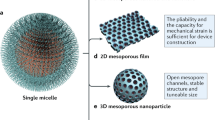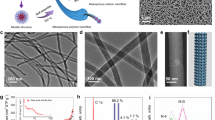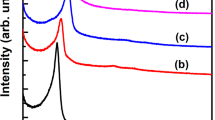Abstract
Ordered porous materials with unique pore structures and pore sizes in the mesoporous range (2–50 nm) have many applications in catalysis, separation and drug delivery. Extensive research has resulted in mesoporous materials with one-dimensional, cage-like and bi-continuous pore structures. Three families of bi-continuous mesoporous materials have been made, with two interwoven but unconnected channels, corresponding to the liquid crystal phases used as templates. Here we report a three-dimensional hexagonal mesoporous silica, IBN-9, with a tri-continuous pore structure that is synthesized using a specially designed cationic surfactant template. IBN-9 consists of three identical continuous interpenetrating channels, which are separated by a silica wall that follows a hexagonal minimal surface. Such a tri-continuous mesostructure was predicted mathematically, but until now has not been observed in real materials.
This is a preview of subscription content, access via your institution
Access options
Subscribe to this journal
Receive 12 print issues and online access
$259.00 per year
only $21.58 per issue
Buy this article
- Purchase on Springer Link
- Instant access to full article PDF
Prices may be subject to local taxes which are calculated during checkout





Similar content being viewed by others
References
Kresge, C. T., Leonowicz, M. E., Roth, W. J., Vartuli, J. C. & Beck, J. S. Ordered mesoporous molecular sieves synthesized by a liquid-crystal template mechanism. Nature 359, 710–712 (1992).
Yanagisawa, T., Shimizu, T., Kuroda, K. & Kato, C. The preparation of alkyltrimethylammonium–kanemite complexes and their conversion to microporous materials. Bull. Chem. Soc. Jpn 63, 988–992 (1990).
Zhao, D. et al. Triblock copolymer synthesis of mesoporous silica with periodic 50 to 300 angstrom pores. Science 279, 548–552 (1998).
Tanev, P. T. & Pinnavaia, T. J. A neutral templating route to mesoporous molecular-sieves. Science 267, 865–867 (1995).
Huo, Q. S. et al. Generalized synthesis of periodic surfactant inorganic composite-materials. Nature 368, 317–321 (1994).
Sakamoto, Y. et al. Direct imaging of the pores and cages of three-dimensional mesoporous materials. Nature 408, 449–453 (2000).
Yu, C. Z., Tian, B. Z., Fan, J., Stucky, G. D. & Zhao, D. Nonionic block copolymer synthesis of large-pore cubic mesoporous single crystals by use of inorganic salts. J. Am. Chem. Soc. 124, 4556–4557 (2002).
Che, S. et al. A novel anionic surfactant templating route for synthesizing mesoporous silica with unique structure. Nature Mater. 2, 801–805 (2003).
Carlsson, A. et al. The structure of MCM-48 determined by electron crystallography. J. Electron Microsc. 48, 795–798 (1999).
Gao, C., Sakamoto, Y., Sakamoto, K., Terasaki, O. & Che, S. Synthesis and characterization of mesoporous silica AMS-10 with bicontinuous cubic Pn3¯m symmetry. Angew. Chem. Int. Ed. 45, 4295–4298 (2006).
Finnefrock, A. C. et al. Metal oxide containing mesoporous silica with bicontinuous plumber's nightmare morphology from a block copolymer–hybrid mesophase. Angew. Chem. Int. Ed. 40, 1208–1211 (2001).
Huo, Q. S., Margolese, D. I. & Stucky, G. D. Surfactant control of phases in the synthesis of mesoporous silica-based materials. Chem. Mater. 8, 1147–1160 (1996).
Hyde, S. T. & Schröder, G. E. Novel surfactant mesostructural topologies: Between lamellae and columnar (hexagonal) forms. Curr. Opin. Colloid Interface Sci. 8, 5–14 (2003).
Hyde, S. T. in Handbook of Applied Surface and Colloid Chemistry (ed. Holmberg, K.) Ch. 16, 299–332 (Wiley, 2001).
Hyde, S. T. Bicontinuous structures in lyotropic liquid crystals and crystalline hyperbolic surfaces. Curr. Opin. Solid State Mater. 1, 653–662 (1996).
Schoen, A. H. Infinite Periodical Minimal Surface without Intersections. Technical Note D-5541 (NASA, Washington DC, 1970).
Zeng, X., Ungar, G. & Imperor-Clerc, M. A triple-network tricontinuous cubic liquid crystal. Nature Mater. 4, 562–567 (2005).
Yu, T. et al. Pore structures of ordered large cage-type mesoporous silica FDU-12s. J. Phys. Chem. B 110, 21467–21472 (2006).
Hovmöller, S. CRISP: Crystallographic image processing on a personal computer. Ultramicroscopy 41, 121–135 (1992).
O'Keeffe, M. et al. Reticular Chemistry Structure Resource <http://rcsr.anu.edu.au/>.
Hyde, S. T. & Oguey, C. From 2D hyperbolic forests to 3D Euclidean entangled thickets. Eur. Phys. J. B 16, 613–630 (2000).
Brakke, K. The surface evolver. Exp. Math. 1, 141–165 (1992).
Huo, Q. S. et al. Room temperature growth of mesoporous silica fibers: A new high-surface-area optical waveguide. Adv. Mater. 9, 974–978 (1997).
Tolbert, S. H. et al. Phase transitions in mesostructured silica/surfactant composites: Surfactant packing and the role of charge density matching. Chem. Mater. 13, 2247–2256 (2001).
Beck, J. S. et al. A new family of mesoporous molecular sieves prepared with liquid crystal template. J. Am. Chem. Soc. 114, 10834–10843 (1992).
Vartuli, J. C. et al. Effect of surfactant/silica molar ratios on the formation of mesoporous molecular sieves: Inorganic mimicry of surfactant liquid-crystal phases and mechanistic implications. Chem. Mater. 6, 2317–2326 (1994).
Oleynikov, P. eMap: A program for computational crystallography. AnaliteX Crystallographic Computing <http://www.analitex.com> (2008).
Acknowledgements
We thank C. Bonneau for discussion related to topology and minimal surfaces, and P. Oleynikov for software assistance. This research is supported by the Institute of Bioengineering and Nanotechnology (Biomedical Research Council, Agency for Science, Technology and Research, Singapore), the Swedish Research Council (VR) and the Swedish Governmental Agency for Innovation Systems (VINNOVA). J.-L.S. is supported by a postdoctoral grant from the Carl-Trygger Foundation.
Author information
Authors and Affiliations
Contributions
J.Y.Y. and X.-D.Z. led the research at IBN and SU, respectively. Y.H. synthesized and characterized the mesoporous silica materials. L.L.C. synthesized the surfactant. Y.H., D.-L.Z. and L.Z. conducted the TEM studies. D.-L.Z. and J.-L.S. performed the structural determination and topological analysis. Y.H., D.-L.Z., J.Y.Y., X.-D.Z. and J.-L.S. wrote the paper.
Corresponding authors
Supplementary information
Supplementary information
Supplementary information (PDF 2681 kb)
Supplementary information
Supplementary movie S1 (WMV 5151 kb)
Rights and permissions
About this article
Cite this article
Han, Y., Zhang, D., Chng, L. et al. A tri-continuous mesoporous material with a silica pore wall following a hexagonal minimal surface. Nature Chem 1, 123–127 (2009). https://doi.org/10.1038/nchem.166
Received:
Accepted:
Published:
Issue Date:
DOI: https://doi.org/10.1038/nchem.166
This article is cited by
-
Bulk and local structures of metal–organic frameworks unravelled by high-resolution electron microscopy
Communications Chemistry (2020)
-
Recent Advances of Supercritical CO2 in Green Synthesis and Activation of Metal–Organic Frameworks
Journal of Inorganic and Organometallic Polymers and Materials (2020)
-
Imaging defects and their evolution in a metal–organic framework at sub-unit-cell resolution
Nature Chemistry (2019)
-
Bragg-mirror-like circular dichroism in bio-inspired quadruple-gyroid 4srs nanostructures
Light: Science & Applications (2016)
-
Fischer-Trospch Synthesis on Ordered Mesoporous Cobalt-Based Catalysts with Compact Multichannel Fixed-Bed Reactor Application: A Review
Catalysis Surveys from Asia (2016)



